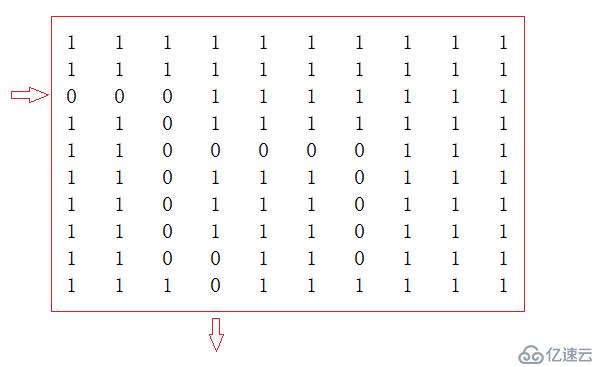溫馨提示×
您好,登錄后才能下訂單哦!
點擊 登錄注冊 即表示同意《億速云用戶服務條款》
您好,登錄后才能下訂單哦!
我們看下面這個迷宮----方陣(也可以是矩陣):

迷宮入口是坐標(2,0)位置,出口是(9,3)。我們假定0代表通路,1代表不通。
現在需要找到哪一條路是通路。我們的思想是借助棧,“回溯法”。回溯是什么意思呢???先從起點出發,檢查它的上下左右是否是通路(即是否有為數字0處)。也就是說為0通了,壓棧,將此位置元素變成2,這樣做的好處是明確通路路徑。然后繼續往下走,判斷上下左右 。直至我們找到終點(縱坐標在矩陣的最后一行)。
我們來看下我針對迷宮問題實現的代碼:
#include<stack>
#include<assert.h>
#define N 10 //該迷宮10*10.
struct Pos //定義一個結構體,該結構體用來表示坐標。
{
int _row;
int _col;
Pos(int row,int col)
:_row(row)
, _col(col)
{}
};
template<class T>
bool SearchMazePath(int* a, int n, Pos entry, stack<T>& paths) //尋找迷宮是否有通路。
{
assert(a);
paths.push(entry);
while (!paths.empty())
{
Pos cur = paths.top();
a[cur._row*n + cur._col] = 2;
if (cur._row == n - 1)
{
return true;
}
//上
Pos tmp = cur;
--tmp._row;
if (a[tmp._row*n + tmp._col] == 0)
{
paths.push(tmp);
continue;
}
//下
tmp = cur;
++tmp._row;
if (a[tmp._row*n + tmp._col] == 0)
{
paths.push(tmp);
continue;
}
//左
tmp = cur;
--tmp._col;
if (a[tmp._row*n + tmp._col] == 0)
{
paths.push(tmp);
continue;
}
//右
tmp = cur;
++tmp._col;
if (a[tmp._row*n + tmp._col] == 0)
{
paths.push(tmp);
continue;
}
paths.pop(); //若上下左右都不通,則回溯。
}
return false;
}
void GetMaze(int* a, int n) //讀取到迷宮圖案
{
assert(a);
FILE* fout = fopen("MazeMap.txt", "r");
assert(fout); //若文件打開失敗,后續工作則無法完成,因此采用assert防御式編程。
for (int i = 0; i < n; i++)
{
for (int j = 0; j < n; j++)
{
while (true)
{
int men = fgetc(fout); //讀取字符
if (men == '0' || men == '1') //是0或者1則轉換成數字到二維矩陣中存儲。
{
a[i*n + j] = men -'0';
break;
}
}
}
}
}
void PrintMaze(int* a, int n) //將此迷宮打印出來
{
for (int i = 0; i < n; i++)
{
for (int j = 0; j < n;j++ )
{
cout << a[i*n + j] << " ";
}
cout << endl;
}
cout << endl;
}
void Test()
{
int a[N][N] = {};
Pos sp(2, 0); //入口坐標
GetMaze((int*) a, N);
PrintMaze((int*)a, N);
stack<Pos> paths;
SearchMazePath((int*)a, N, sp, paths);
//二維數組實際存儲是一維數組,將二維數組強制轉換為一維數組傳參。
PrintMaze((int*)a, N);
}
int main()
{
Test();
system("pause");
return 0;
} 有時候,針對迷宮問題,我們還需要求多條路徑的最優解(最短路徑)。那這時候我們可以用壓棧,利用棧幀一層一層壓棧的特點實現。
免責聲明:本站發布的內容(圖片、視頻和文字)以原創、轉載和分享為主,文章觀點不代表本網站立場,如果涉及侵權請聯系站長郵箱:is@yisu.com進行舉報,并提供相關證據,一經查實,將立刻刪除涉嫌侵權內容。